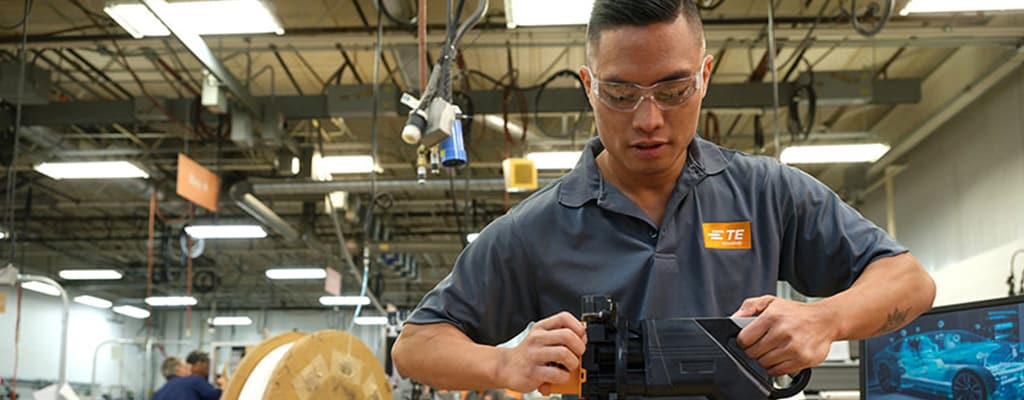
Racing The Clock
Consumer demand is creating a time crunch for engineers tasked with product innovation. TE can help you be successful in a world of shorter design cycles.
The Challenges of Shorter Design Cycles
Product innovation has entered a new era of unprecedented speed and complexity. Engineers are constantly challenged to keep up with the relentless demand for faster, smaller, more connected, and more integrated products that meet ever-evolving customer needs. From mobile technology and automation to LED lighting and energy storage, the race to market has never been more intense.
This evolution of product innovation has had a profound impact on engineers. Shorter design cycles pose challenges and there are pros and cons of rapid time-to-market. Engineers need to be able to navigate these changes in order to excel in this fast-paced landscape.

From a Decade to a Year
Expedited Timelines
The automation market has undergone a seismic shift in recent years, driven by the increasing demands for more accessible, up-to-date systems that seamlessly integrate across manufacturers’ platforms. The advent of powerful computing, increased communication bandwidth, and the wider reach of open technologies have all contributed to this paradigm shift. Design cycle updates have progressed from a single update per decade to multiple updates in hardware and several yearly updates in software.
The push toward shorter design cycles is rooted in the need to meet the ever-evolving demand of consumers. While some use cases have remained constant, new control technologies
- Ivan Ruiz Stubelj,
- Global Manager of Strategic Business Development
Leveraging AI and Robotics
Agile and Adaptable Development Cycles
Artificial intelligence, machine learning, and robotics are being leveraged to create solutions that help businesses automate complex processes. Small and midsized companies often leverage more agile and adaptable development cycles, allowing them to quickly pivot and respond to customer demands through product iterations until they find the right product-market fit.

High Demand for New Products
There has been a similar shift in the industrial market over the past 25 years. For example, the battery management system (BMS) market is currently experiencing an all-time high demand for new products and updates. Customers are seeking faster, more efficient, and more innovative solutions to meet their needs, particularly in energy management systems. LED technology has allowed for more efficient lighting that can now be tailored to reduce energy consumption by dimming or switching lights when not needed. Additionally, innovations in the horticulture market are benefiting from tailored light spectra to optimize plant growth. All of this fast-to-market product innovation requires equally fast engineering work.
Other market innovations driving new product designs include drones, green energy, and the rise of 3D printing, which is revolutionizing prototyping by enabling the creation of pre-series products using materials that meet basic industry standards. And software development continues to advance. It’s expected that more human-machine interface (HMI) development will become software-based and become a key differentiator for product design. With the pace of innovation continuing to accelerate, engineers will need to stay on top of these new trends to design products that meet the ever-changing needs of the market.

Consumer Gains Bring Design Challenges
Growing Availability of Online Resources
While the fast-paced design environment is exciting for consumers who want new updates and releases, it can be taxing for engineers and designers who are completing the same amount of work but in a much shorter time and often with fewer resources available to them. To be successful in a world of shorter design cycles, engineers can be proactive in finding strong suppliers who will help them through the challenges. TE understands the difficulties of sourcing electrical components for product designs and the increasing demands of shorter design cycles. We know that reliability, safety, and trust are key pillars you need in a partner to be successful.
Tips for Design Engineers With Short Deadlines
This can help to clarify standards, requirements, and protocols that are mandatory for the project. From collaborating with key suppliers at an early stage to prioritizing tasks and working closely with team members, TE can help you be successful in a world of shorter design cycles.
This can help to clarify standards, requirements, and protocols that are mandatory for the project. From collaborating with key suppliers at an early stage to prioritizing tasks and working closely with team members, TE can help you be successful in a world of shorter design cycles.
This can help to clarify standards, requirements, and protocols that are mandatory for the project. From collaborating with key suppliers at an early stage to prioritizing tasks and working closely with team members, TE can help you be successful in a world of shorter design cycles.

